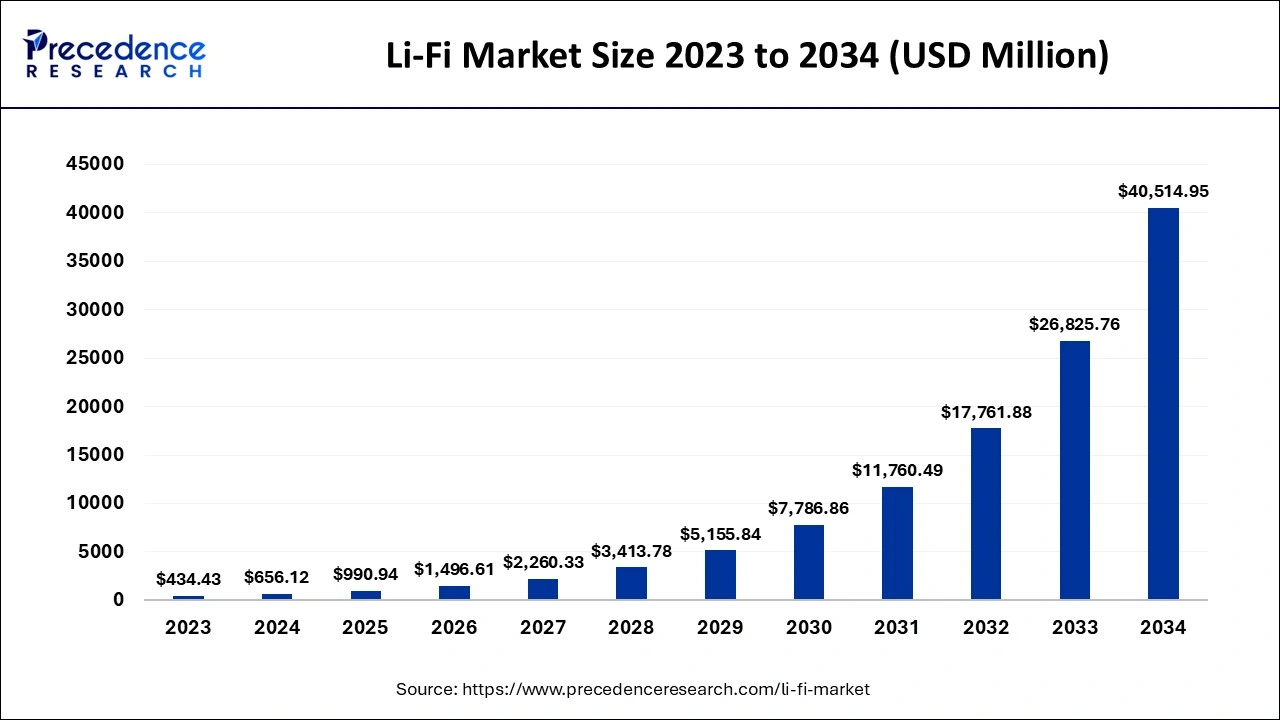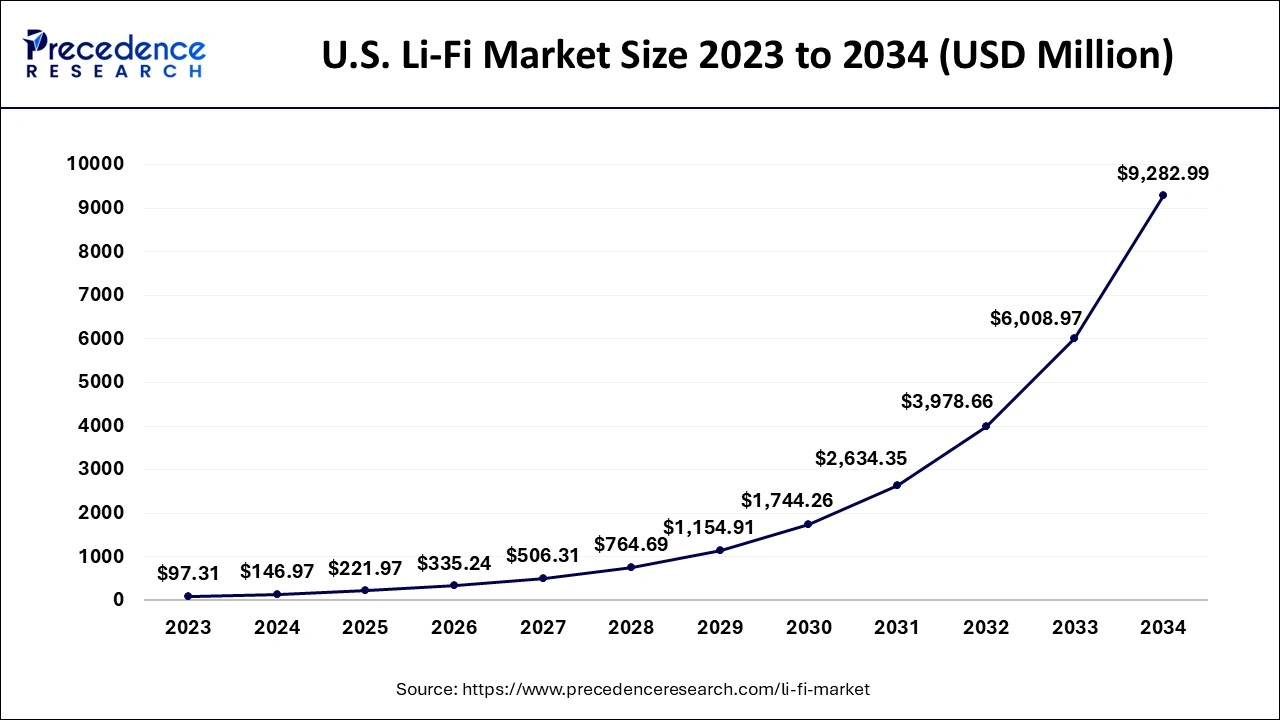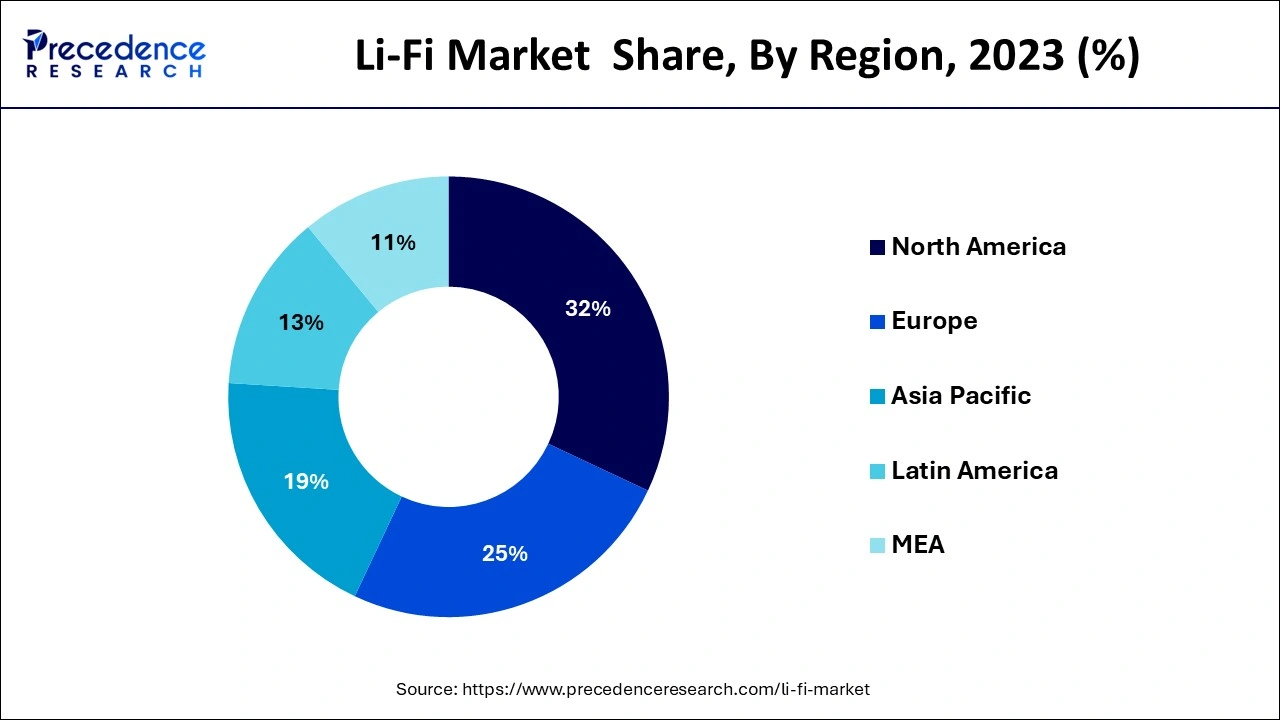The global Li-Fi market size accounted for USD 656.12 million in 2024, grew to USD 990.94 million in 2025 and is predicted to surpass around USD 40514.95 million by 2034, representing a healthy CAGR of 51.03% between 2024 and 2034. The North America Li-Fi market size is calculated at USD 209.96 million in 2024 and is expected to grow at a fastest CAGR of 51.24% during the forecast year.
The global Li-Fi market size is estimated at USD 656.12 million in 2024 and is anticipated to reach around USD 40514.95 million by 2034, expanding at a CAGR of 51.03% from 2024 to 2034.

The U.S. Li-Fi market size is evaluated at USD 146.97 million in 2024 and is predicted to be worth around USD 9282.99 million by 2034, rising at a CAGR of 51.34% from 2024 to 2034.

Depending upon the region, the North American market is expected to have the largest market share across the globe. Due to the technological advancements increasing demand for the energy energy efficient devices and the growing need for high speed bandwidth in the countries in the North American region are the major reasons for the growth of this region. Better ecosystem of the countries in this region helps in the introduction of modern technology and it is also conducive for delivering excellent communication quality. North American region is the pioneer of various technological innovations like smart cities smart buildings, cloud computing, electronic products and Internet of Things. North American region has emerged as the center of market demand for this technology. There's an increased usage of this technology in subsea communication applications and marine communication applications. The United states Navy it's producing state of the art networking technology with the help of this Li-Fi technology to resolve the issue of the subsea connectivity.

Followed by the North American market the European market is also expected to register a significant growth during the forecast period. The Europe region was valued at USD 33 million in 2023 and UK held 30% of the revenue share. This region has a well established automotive sector across many countries. The use of this technology can be made for vehicle to vehicle connectivity in the autonomous cars, it can also be used to avoid possible collisions and the use of this technology can also help the vehicles to differentiate between the nonhuman objects and the humans. The use of vehicle to vehicle connectivity will also provide and advantage of avoiding the overcrowded or congested roads. This helps in improving the decision making capability of these automated vehicles. Due to the increase in the various innovative technologies into the modern cars there'll be a significant increase in the acceptance of this technology for the automotive industry. All of these factors are expected to boost the growth of this market in the European region.
The Li-Fi technology was first introduced in the year 2011. It is a light communication system which is capable of transmitting information at high speed over ultraviolet infrared spectrums and visible light. The technology is similar to Wi-Fi but the most important difference is that Wi-Fi uses radio frequency whereas Li-Fi uses the modulation of light intensity to transfer data. Li-Fi can be used as they are functional in many areas which are otherwise susceptible to electromagnetic interference. Li-Fi network connections are more secure and easier to control as the shortwave radiations do not penetrate through walls and doors. Since light can travel through water Li-Fi can be used for communication in water bodies up to 200 meters. This technology may be used in other environments like the commercial passenger aircrafts.
The growth of the Li-Fi market is due to the factors like the growing demand for indoor wireless communication technology across the commercial sector and the increasing implementation of the Li-Fi fire light as a service and many other optical sensing based technologies which are used in education sector and the healthcare industry. Increased use of smart devices and the construction of smart cities in many developed and developing nations is driving the market. Compared to the Wi-Fi technology the Li-Fi technology is cheaper and extremely environment friendly. Li-Fi technology has a potential application across many industries. It can be used in location based services, mobile connectivity, in hazardous environments and smart lighting.
The high number of connected devices pertaining to the wide bandwidth of the connection proves to be a challenge. This is impacting the quality of service offered. The lifestyle technology makes use of visible light containing for data processing and it is extremely free from any constraints. Therefore the market is expected to see a growth during the forecast period. Policymakers across the globe or aiming for low carbon economy and for smart cities which are offering discounted prices for LED bulbs which is creating a demand and raising the application rate. These developments increase the range of potential of the Li-Fi systems.
Smart buildings or providing improved residential comfort and experience to the residents by knowing the locations of each occupant and providing services like intelligent car parking, logistics, health monitoring and shopping assistance. The basic idea of this technology is to make use of the visible light from the LED light bulb to transfer high speed data to a photodetector which is connected with the smart phone or the tablet. Increasing research in the Li-Fi networking techniques is providing interference mitigation, multiuser access and mobility support.
Many products are developed which have enabled wireless networking with the light. This technology is expected to be much cheaper as an extensive use of LED light bulbs in the buildings which provide a large bandwidth of visible light. The increasing growth of the use of lead bulbs in various buildings is providing growth opportunities for this market.
| Report Coverage | Details |
| Market Size by 2024 | USD 656.12 million |
| Market Size by 2034 | USD 40514.95 million |
| Growth Rate from 2024 to 2034 | CAGR of 51.03% |
| Base Year | 2023 |
| Forecast Period | 2024 to 2034 |
| Segments Covered | Component, Application, End User, Transmission, Geography |
Based on the components, the LED segment accounted revenue share of 48% in 2023 and is expected to hit around USD 651 million by 2034. The increased adoption of LED bulbs and the reducing cost of these LED bulbs is expected to drive the market for the lead segment during the forecast period. Deployment of these leads in various industries for many purposes is also expected to boost the revenue growth of this segment during the anticipated. There's an increasing demand for a lead in these systems as there are many advantages of these leads like longevity high energy output and power efficiency. These benefits are considered to be the major driving forces for this market. Turning on and off of the lead will help in creating a digital string of binary digits and these can be interpreted in the light utilizing the blends of blue green or red leads by adjusting the flashing frequency. There's an increasing investments for research and development in this field. Advancements in technology is anticipated to lead to a system where illumination will be used for high speed communication systems across the globe.
The photodetector segment is also expected to register a significant growth during the forecast period. Increasing use of photodetectors like photodiodes which are used to track and interpret various images is expected to drive the market. The photodiode is a photodetector that gives out electromagnetic voltage which is equal to the optical signal that appears on the photodetectors surface.
Based on application, the indoor networking segment is expected to have the largest market share in terms of revenue during the forecast period. There's an increasing application of this technology based indoor networking systems in the educational sectors, retail sectors and the healthcare sectors. This technology is extremely secure and it is used in several healthcare applications. In the medical field this technology is used in waiting rooms, patient rooms, corridors and also in the operating theatres. This technology will enable a lightning communication system to eliminate the problems of electronic radiation which come out of the smartphones. This technology is extremely useful for real time tracking of the patients movements and also for documentation of the patient movements. It is also helpful in noting the vital signals without the use of cables. This technology provides an integrated network access which is extremely safe for usage across an entire campus in the universities, dormitories and even classrooms. Many institutions have started adopting this technology in their classes. This technology can also be used to find the particular items within a shop. This technology shall be extremely useful for obtaining discount wallets, reviewing the inventory stock of various products on the shelves reviewing the store promotions and to enhance the overall shopping experience of the customers.
The location based services segment is expected to have a significant growth 51% during the forecast period. This technology is able to provide efficiency in the indoor areas with dependable location Information Services. This location based service provides advanced mapping applications to the retailers which help them in calculating and correctly visualizing the foot traffic flow. This technology also helps in maximizing the details of the indoor floor plans and the outdoor floor plans which helps the shopper by guiding them with the use of their smartphones to the place where their interest lies.
On the basis of the end user, the retail segment is estimated to lead the market in terms of revenue. The retail segment is expected to grow well during the forecast period. As there is an increase in the implementation of this technology in the retail sector this segment is expected to grow. This technology is also extensively employed in the indoor retail outlets which are mostly used as a position element which helps in enhancing the shopping experience for the customers by exhibiting all the new promotional deals and discount offers available. This flashing illumination can be seen with a smartphone that allows the indoor movement. This is done with the help of light bulbs and LEDs. Consumer satisfaction shall be boosted in the retail sales due to the application of these elements. This technology is also useful as it allows the retailers to identify the customer preferences it also helps in understanding the behavior of the consumers. This technology is extremely useful in using the targeted marketing strategies. The sales in the retail sector will increase due to the display of these advertisement campaigns. This technology also helps in keeping a check on the inventory status which is real time. Shopping centers and malls have a benefit by the use of this technology as it helps them in becoming a pioneer in attracting and shaping the consumers awareness.
The automotive segment is also expected to have a good amount of growth in terms of revenue during the anticipated time. Various technological developments in the lead and vehicle connectivity elements will help in increasing the implementation of car and traffic lights. Increasing standards and policies for traffic management and road safety with monitoring through applications will help to achieve the target of increasing the revenue growth of this segment.
By Component
By Application
By End User
By Transmission
By Geography
For inquiries regarding discounts, bulk purchases, or customization requests, please contact us at sales@precedenceresearch.com
No cookie-cutter, only authentic analysis – take the 1st step to become a Precedence Research client